Concerned about knee injuries from running? You’re not alone. Research shows that up to 50 percent of runners experience a knee-related injury annually, with runner’s knee making up 16 to 25 percent of those cases. Left unaddressed, these issues can lead to chronic pain or lasting joint damage. Fortunately, most running-related knee injuries are preventable. This guide covers expert strategies to protect your knees, including proper footwear, strength training, warm-ups, and training habits to help you run safely and pain-free.
Key Takeaways
-
Understanding the causes of knee injuries, such as overuse, muscle imbalances, and biomechanical issues, is crucial for prevention.
-
Selecting the appropriate running shoes and incorporating dynamic stretches can significantly reduce the risk of knee injuries.
-
Regular strength training, gradual progression in training, and maintaining a healthy body weight are essential strategies for supporting knee health.
Understand the Causes of Knee Injuries
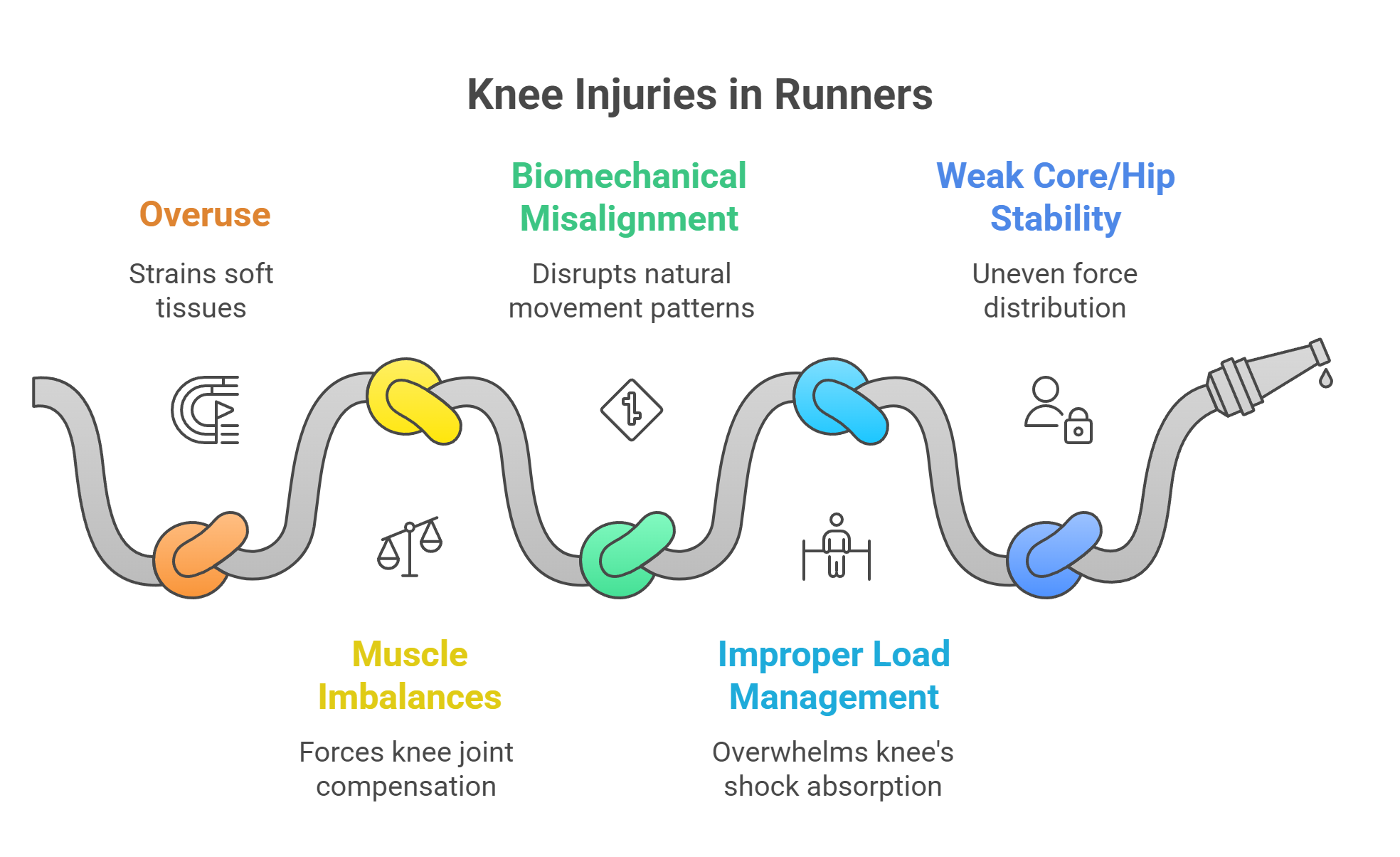
Knee injuries while running are rarely the result of a single factor. For many runners, knee pain builds up over time due to repetitive stress, poor mechanics, or imbalanced muscles. Identifying the underlying causes is key to recognizing when a minor issue could lead to something more serious.
1. Overuse and Repetitive Stress
Frequent running without enough recovery can strain the soft tissues surrounding the knee. Repetitive movements can affect ligaments, muscles, and cartilage, leading to inflammation, swelling, and pain. Overuse injuries account for up to 50% of all running-related complaints in clinical settings.
2. Muscle Imbalances
When the supporting muscles in the hips, glutes, hamstrings, or quadriceps, are weak or tight, the knee joint is forced to compensate. This imbalance can pull the kneecap out of alignment and place added stress on nearby joints and bones. Muscle imbalance is a leading contributor to patellofemoral pain syndrome, commonly known as runner’s knee, and affects both the front and sides of the knee.
3. Biomechanical Misalignment
Poor alignment in the legs, feet, or hips can disrupt natural movement patterns. For example, overpronation of the feet or hip instability can affect how the kneecap moves, leading to uneven joint pressure. Many runners develop chronic pain due to these misalignments, especially if left uncorrected.
4. Improper Load Management
Sudden increases in mileage or intensity can overwhelm the knee’s ability to absorb shock. The acute-to-chronic workload ratio is one metric researchers use to evaluate this. When runners exceed safe load thresholds, their risk of injury increases substantially. High weekly mileage, especially beyond 64 kilometers (40 miles) per week, has been linked to higher rates of overuse injuries.
5. Weak Core and Hip Stability
Weakness in the core and hips affects posture and gait, leading to compensatory movement patterns. This creates uneven force distribution through the leg and causes the knee to bear more load than it should. These forces can lead to long-term joint damage and cartilage wear, particularly in the patella and surrounding structures.
Choose the Right Running Shoes
The type of running shoes you wear plays a critical role in reducing the risk of running knee injuries. Proper footwear not only improves performance but also offers essential support to absorb shock and minimize strain on your leg muscles and joints.
In fact, studies show that incorrect footwear contributes to a significant portion of overuse injuries in runners, including patellofemoral pain syndrome, runner’s knee, and other common knee injuries.
To find the right pair, it’s essential to understand your running mechanics. A gait analysis can help identify issues like overpronation or underpronation, which affect how your feet strike the ground and how pressure travels up the leg.
If your feet roll excessively inward, stability running shoes may help realign your stride and prevent injury by reducing stress on the kneecap, thigh bone, and surrounding structures. This is especially helpful if you're managing an existing knee injury or recovering from runner’s knee.
Check your current shoes for uneven wear, which can signal the need for a better fit. Also remember:
-
Running shoes lose cushioning and support after 400 to 500 miles
-
Worn-out shoes can increase the risk of muscle fatigue, sore knees, and joint strain
-
Replace your shoes regularly to avoid worsening muscle tightness and aggravating an injured joint
Choosing shoes that match your foot type, stride, and terrain reduces the risk of overloading your knees bent in poor alignment. Pairing this with physical therapy and hamstring stretches can improve joint health, especially for runners carrying extra weight. Maintaining a healthy body weight also decreases force on the knees and extends the life of your footwear.
When chosen correctly, running shoes act as the first line of defense against runner’s knee, helping you move better, feel stronger, and run longer, without the pain.
Warm Up with Dynamic Stretches
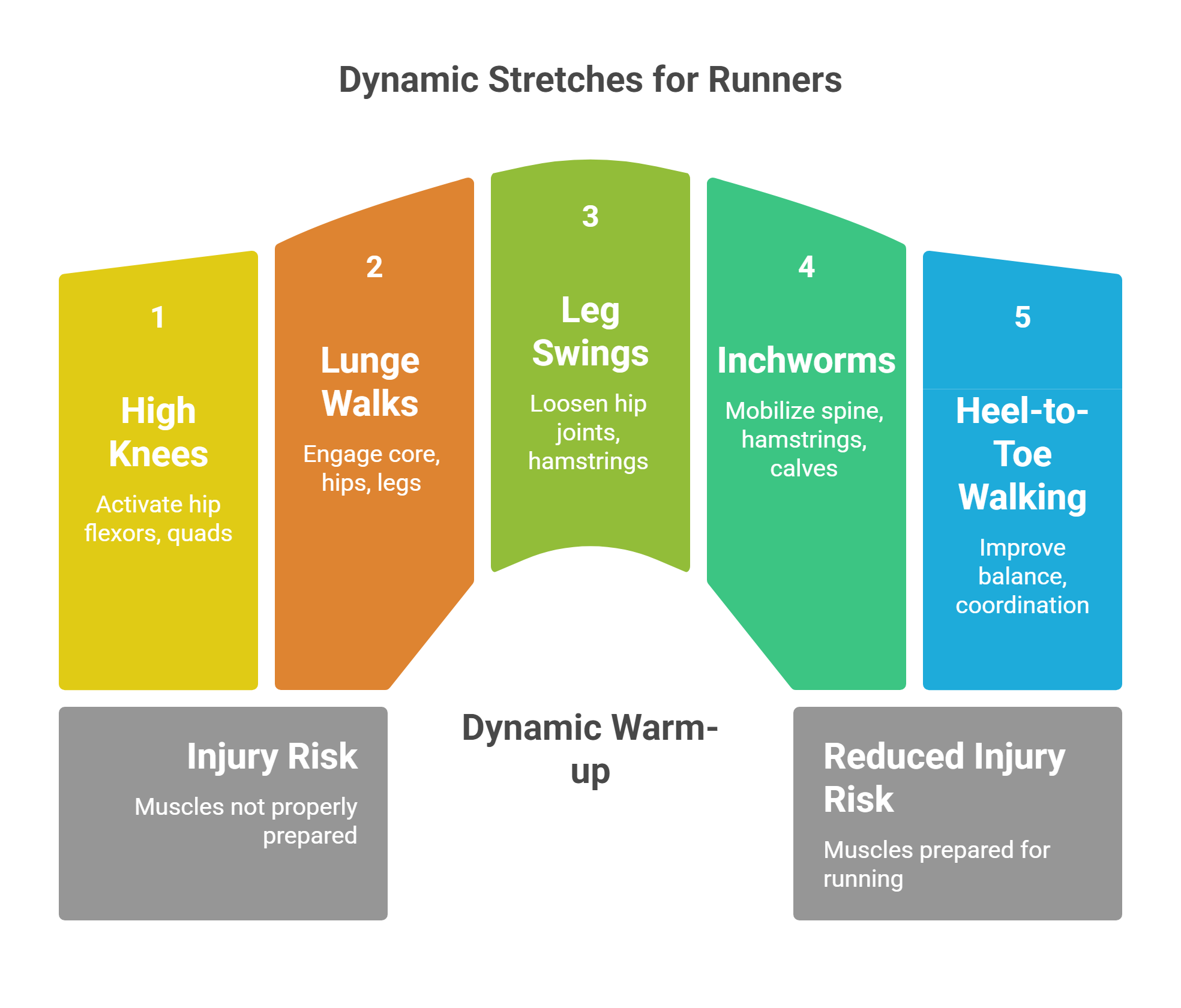
Warming up with dynamic stretches is one of the most effective ways to prepare your muscles, increase blood flow, and protect your joints before a run. Unlike static stretching, which can limit performance when done pre-run, dynamic movements activate the leg muscles, improve mobility, and reduce the risk of injury.
Dynamic stretches boost circulation and flexibility, helping you move better from the first step. Research published in the Journal of Strength and Conditioning Research shows that dynamic warm-ups can reduce lower-body injuries in runners by up to 30 percent compared to no warm-up or static stretching alone.
Some of the most effective dynamic stretches for runners include:
-
High knees to activate hip flexors and quadriceps
-
Lunge walks and lunges with a twist to engage the core, hips, and legs
-
Leg swings (forward and lateral) to loosen the hip joints and hamstrings
-
Inchworms to mobilize the spine, hamstrings, and calves
-
Heel-to-toe walking for improving balance and coordination
These movements stretch and engage the same muscles used in running —hamstrings, glutes, quads, and calves, without overstressing them. This is especially important for runners who may have tight muscles from previous sessions.
By gradually increasing your heart rate and activating key muscle groups, a dynamic warm-up not only improves performance but also helps prevent injuries such as runner’s knee, patellofemoral pain syndrome, and ligament strain.
Make it a habit to spend 5 to 10 minutes on dynamic stretches before every run. It’s a simple and powerful step that supports healthy joints, prevents swelling, and reduces unnecessary stress on the knees.
Focus on Strength Training
Strength training is a crucial part of any runner’s routine. It not only boosts running performance but also protects the knee by improving muscle balance and movement control. Studies show that incorporating a structured strength-training program can reduce lower-limb injuries in runners by up to 25%.
Weak hips, core, or iliotibial band muscles can lead to compensation patterns that stress the knee, increasing the risk of conditions like iliotibial band syndrome and runner’s knee. Improving muscular strength, especially in the legs and core, helps maintain good form during runs and supports the joints during high-impact activity.
Some of the most effective strength training exercises include:
-
Single-leg bridge holds to activate glutes and stabilize the pelvis
-
Lateral step downs to improve hip control
-
Wall sits and split squats for quadriceps endurance
-
Side-lying leg raises for abductors
-
Standing fire hydrants to strengthen the glutes and IT band
-
Lunges, which improve balance and enhance key leg muscles
Focusing on unilateral (single-leg) exercises two or more times per week can significantly reduce knee strain, especially during long-distance running.
Additionally, core strength helps stabilize your torso and pelvis, keeping your running technique efficient. When many runners overlook this, poor trunk control can disrupt their stride and increase load on the lower joints.
Suppose you're unsure about your form or muscle imbalances. In that case, a gait analysis can identify potential problem areas and recommend the best course of action for strengthening weak links in your chain.
Avoid over-reliance on static stretches for injury prevention. Instead, balance strength training with brilliant mobility work to maintain flexibility, reduce inflammation, and stay resilient against overuse injuries.
Stronger muscles support better alignment, reduce strain on the knee, and help you train consistently so that you can chase that runner’s high safely.
Implement Gradual Progression in Training

Building endurance is essential, but pushing too hard, too soon, is one of the most common causes of knee injuries. Runners who increase their training volume or intensity too quickly are at a significantly higher risk of developing pain, especially around the knees and joints.
According to research published in the British Journal of Sports Medicine, rapid weekly mileage increases are one of the leading predictors of running-related injuries. Running more than 64 kilometers per week significantly increases your injury risk, especially if not supported by a well-planned progression strategy.
To protect your knees and avoid setbacks:
-
Increase your long-distance runs by no more than 10 percent per week
-
Monitor your acute-to-chronic workload ratio (ACWR) to track your body’s capacity to handle stress
-
Allow adequate rest days to give your muscles, ligaments, and joints time to adapt
Sharp spikes in training load not only cause muscle fatigue but also overload cartilage, tendons, and bones, potentially leading to overuse injuries like patellofemoral pain syndrome or iliotibial band syndrome.
Even many runners with solid experience may overlook the importance of progression. A steady, gradual increase in distance and intensity helps strengthen the entire lower body and reduces the stress on the knees with each stride.
Innovative training progression means your running technique stays efficient, your injury risk remains low, and your performance continues to improve without unwanted downtime.
Maintain Flexibility with Post-Run Static Stretches
Skipping your post-run stretch can lead to increased muscle tightness, poor flexibility, and a higher risk of knee injuries. Static stretches after running help lengthen the muscles that contract during exercise, reducing inflammation, enhancing recovery, and improving joint mobility.
A study published in the Journal of Athletic Training found that regular static stretching significantly reduces delayed-onset muscle soreness (DOMS) and improves range of motion, particularly in the hips, quads, and hamstrings.
Key areas to stretch after a run include:
-
Quadriceps
-
Hamstring stretches
-
Calves
-
Hip flexors
-
Glutes
Hold each stretch for 20 to 30 seconds without bouncing. For instance, a Standing Quadriceps Stretch held for 30 seconds helps release tension in the front of the thigh, relieving pressure from the kneecap and joints.
Consistently stretching after runs:
-
Supports proper alignment of the legs and knees
-
Improves running performance by increasing stride efficiency
-
Helps prevent common knee injuries like runner's knee and iliotibial band syndrome
Post-run static stretches are a low-effort, high-impact habit that protects your knees, helps you recover faster, and keeps your stride fluid for your next workout.
Improve Running Technique
Enhancing your running technique is crucial for preventing knee injuries. To improve your good form and protect your knees:
-
Avoid overstriding to prevent undue stress on the knees.
-
Keep a straight back.
-
Maintain relaxed shoulders.
-
Keep an upright head.
To lessen knee joint impact while running, consider the following adjustments:
-
Opt for a midfoot strike instead of a heavy heel strike.
-
Increase your cadence, or the number of steps you take per minute.
-
Take shorter, faster strides.
These changes can help reduce inflammation the impact on your knees and hips.
Working with a physical therapy professional can assist in modifying your running technique to alleviate knee pain. Professional gait analysis can identify biomechanical inefficiencies that contribute to knee pain, allowing you to make necessary adjustments to your form. Proper running mechanics are vital for injury prevention and can considerably enhance performance.
Incorporate Recovery Days and Cross-Training
Adding recovery days and cross-training to your routine is crucial to prevent knee injuries. Rest days allow your muscles to repair and adapt, reducing the risk of overuse injuries. Mixing running with other forms of cardio, such as swimming or cycling, can alleviate repetitive strain on the knees.
Swimming provides a full-body workout without excessive strain on the knees, while cycling is a recommended alternative form of cardio for injury-prone runners. Incorporating recovery days and cross-training helps avoid continuous high-impact knee stress and maintains training balance.
Consistent mobility work is also important for reducing injury risk. Addressing restrictions through mobility exercises can improve flexibility and support overall joint health. Prioritizing recovery and incorporating various exercises can improve performance and prevent knee injuries.
Manage Body Weight for Joint Health

Carrying excess body weight puts unnecessary stress on your knee joints, significantly increasing your risk of injury. According to the CDC, every 10 pounds of extra weight adds 30 to 60 pounds of force on your knees with each step during walking or running. This pressure builds up quickly over long distances, contributing to cartilage wear, joint damage, and chronic pain.
Studies show that even a 5% reduction in body weight can lead to noticeable improvements in knee pain, especially for individuals with knee osteoarthritis. Additionally, people who maintain a healthy body weight have a significantly lower risk of developing degenerative joint conditions.
Maintaining a healthy weight supports:
-
Reduced load on joints and ligaments
-
Lower risk of patellofemoral pain syndrome
-
Improved running performance and mobility
-
Less inflammation and better recovery from physical activity
To support joint health and avoid overloading the knees:
-
Incorporate regular strength training and cardio
-
Stay consistent with stretching and recovery routines
-
Stay hydrated and fuel your body with balanced nutrition.
Managing your weight is not just about performance; it's one of the most effective long-term strategies to protect your knees, reduce injury risk, and maintain an active lifestyle.
Seek Professional Advice When Needed
Persistent or worsening knee pain should not be ignored. If your symptoms last more than two weeks or include swelling, instability, or sharp pain, it is essential to consult a healthcare provider. Pain during strength training is also a signal that something may be wrong.
A professional assessment, including gait analysis, can reveal biomechanical issues and guide a personalized treatment plan. Getting support early improves recovery, reduces the risk of further injury, and helps maintain long-term joint health.
Final Thoughts
Preventing knee injuries while running requires a well-rounded approach. Understanding the causes of knee pain, wearing the right running shoes, focusing on strength training, and maintaining flexibility are all essential. Gradually increasing your training load, refining your running technique, and including recovery days and cross-training can further reduce injury risk.
Managing your body weight and consulting a healthcare provider when needed ensures long-term joint health. For runners seeking extra support, the Anaconda Knee Brace provides stability and comfort without limiting mobility. It’s a brilliant addition to your routine, helping you stay active, confident, and injury-free.
Frequently Asked Questions
Quick answers to common running knee concerns.
How can I tell if my running shoes need to be replaced?
Your running shoes should be replaced after 400-500 miles, or if you notice worn-out soles, reduced cushioning, or uneven wear patterns. Regularly check for these signs to ensure optimal performance and support.
What are some effective dynamic stretches to include in my warm-up?
Incorporating high knees, lunge walks, dynamic leg swings, and inchworms into your warm-up routine will effectively prepare your muscles and joints for running. These dynamic stretches enhance flexibility and mobility, setting the foundation for a successful workout.
How can I improve my running technique to prevent knee injuries?
Improving your running technique is essential for preventing knee injuries; focus on maintaining an upright posture, avoiding overstriding, and adopting a midfoot strike. Additionally, increasing your cadence and opting for shorter, faster strides can effectively minimize knee impact.
What should I do if I experience knee pain while running?
If you experience knee pain while running, stop and rest immediately. Should the pain continue for more than two weeks or intensify, consult a healthcare professional for appropriate evaluation and treatment.
How does managing body weight affect knee health?
Managing body weight is essential for maintaining knee health, as excess weight places additional stress on the knees. Even a small weight reduction can significantly lower the risk of knee osteoarthritis and help alleviate pain.
![How to Prevent Knee Injuries When Running? [Top Strategies From Experts]](http://anacondafightwear.co/cdn/shop/articles/How_to_Prevent_Knee_Injuries_When_Running_Top_Strategies_From_Experts.webp?v=1763001667&width=2000)


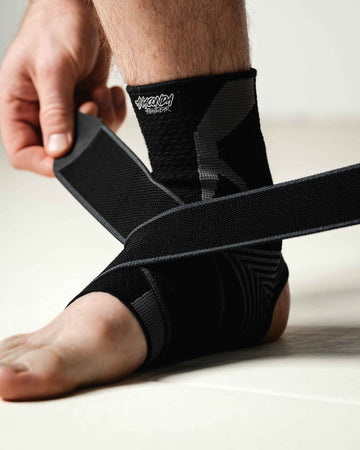



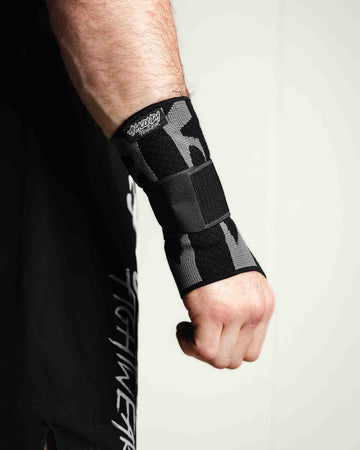

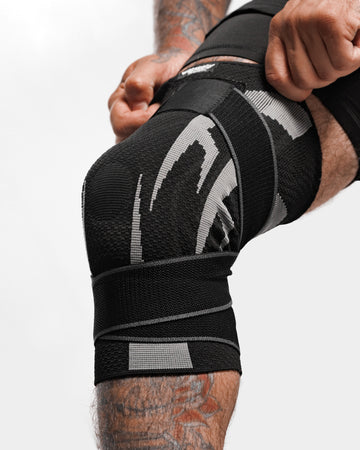



![How Long Does a Knee Injury Take to Heal? [Essential Insights and Tips]](http://anacondafightwear.co/cdn/shop/articles/How_Long_Does_a_Knee_Injury_Take_to_Heal.jpg?v=1764885786&width=533)
